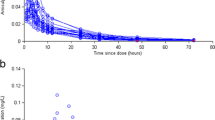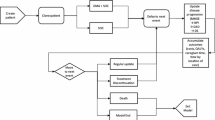Abstract
Background
As the number of Alzheimer's disease (AD) patients steadily increases, many pharmaceutical industries and researchers are making efforts and investments in developing AD treatments. However, numerous AD new drug candidates are frustrated with clearing the hurdles in clinical trials, and few AD treatments have been approved by regulatory agencies worldwide. In order to develop AD treatments, it is essential to consider the characteristics of AD itself and AD patients, and to devise evaluation methods deriving significant clinical safety and efficacy.
Area covered
This review focused on pharmacometrics, the latest mechanism-based PK/PD modeling and simulation approaches among strategies for developing AD treatments. Including the basic concept of pharmacometrics, several cases of applying pharmacometrics to AD treatments in the approval or development stage were categorized as PK, PD, and PK-PD models and reviewed.
Expert opinion
Unlike traditional PK/PD models, the population model-based PK/PD evaluations could apply to sparse data collected from a heterogeneous population. Various covariate factors in patients receiving AD treatments were investigated and quantified through the developed and validated population models. Investigating potential covariates of AD treatments could be employed to optimize the dosage regimen for AD patients. Consequently, a summary of the population PK/PD model will be useful information for clinical pharmacometricians and contribute to the development of AD treatments in the future in decision-making such as dosage optimization.
Similar content being viewed by others
References
Akil A, Bies RR, Pollock BG, Avramopoulos D, Devanand DP, Mintzer JE, Porsteinsson AP, Schneider LS, Weintraub D, Yesavage J, Shade DM, Lyketsos CG (2016) A population pharmacokinetic model for R- and S-citalopram and desmethylcitalopram in Alzheimer’s disease patients with agitation. J Pharmacokinet Pharmacodyn 43:99–109
Breijyeh Z, Karaman R (2020) Comprehensive Review on Alzheimer’s Disease: Causes and Treatment. Molecules 25:5789
Cai Y, Tian Q, Liu C, Fang L (2021) Development of long-acting rivastigmine drug-in-adhesive patch utilizing ion-pair strategy and characterization of controlled release mechanism. Eur J Pharm Sci 161:105774
Choi GW, Lee S, Kang DW, Kim JH, Kim JH, Cho HY (2021) Long-acting injectable donepezil microspheres: Formulation development and evaluation. J Control Release 340:72–86
Choi HY, Kim YH, Hong D, Kim SS, Bae KS, Lim HS (2015) Therapeutic dosage assessment based on population pharmacokinetics of a novel single-dose transdermal donepezil patch in healthy volunteers. Eur J Clin Pharmacol 71:967–977
Cummings J, Bauzon J, Lee G (2021a) Who funds Alzheimer’s disease drug development? Alzheimer’s Dement (n Y) 7:e12185
Cummings J, Lee G, Zhong K, Fonseca J, Taghva K (2021b) Alzheimer’s disease drug development pipeline: 2021. Alzheimers Dement (n Y) 7:e12179
European Medicinnes Agency (2021) Refusal of the marketing authorisation for Aduhelm (aducanumab) (EMA/750220/2021) https://www.ema.europa.eu/en/medicines/human/summaries-opinion/aduhelm. Accessed 25 February 2022
Ferreira D, Perestelo-Pérez L, Westman E, Wahlund LO, Sarría A, Serrano-Aguilar P (2014) Meta-Review of CSF Core Biomarkers in Alzheimer’s Disease: The State-of-the-Art after the New Revised Diagnostic Criteria. Front Aging Neurosci 6:47
Food and Drug Administration (2018) Label information of Aricept (donepezil hydrochloride). https://www.accessdata.fda.gov/drugsatfda_docs/label/2018/020690s042,021720s014,022568s011lbl.pdf. Accessed 18 December 2018
Freudenthaler S, Meineke I, Schreeb KH, Boakye E, Gundert-Remy U, Gleiter CH (1998) Influence of urine pH and urinary flow on the renal excretion of memantine. Br J Clin Pharmacol 46:541–546
Gobburu JV, Tammara V, Lesko L, Jhee SS, Sramek JJ, Cutler NR, Yuan R (2001) Pharmacokinetic-pharmacodynamic modeling of rivastigmine, a cholinesterase inhibitor, in patients with Alzheimer’s disease. J Clin Pharmacol 41:1082–1090
Han S, Lee J, Jeon S, Hong T, Yim DS (2012) Mixed-effect circadian rhythm model for human erythrocyte acetylcholinesterase activity–application to the proof of concept of cholinesterase inhibition by acorn extract in healthy subjects with galantamine as positive control. Eur J Clin Pharmacol 68:599–605
Hing JP, Piotrovsky V, Kimko H, Brashear HR, Zhao Q (2005) Pharmacokinetic simulation for switching from galantamine immediate-release to extended-release formulation. Curr Med Res Opin 21:483–488
Ho T, Pollock BG, Mulsant BH, Schantz O, Devanand DP, Mintzer JE, Porsteinsson AP, Schneider LS, Weintraub D, Yesavage J, Drye LT, Munro CA, Shade DM, Lyketsos C, Bies R (2016) R- and S-citalopram concentrations have differential effects on neuropsychiatric scores in elders with dementia and agitation. Br J Clin Pharmacol 82:784–792
Holford NH, Peace KE (1992a) Methodologic aspects of a population pharmacodynamic model for cognitive effects in Alzheimer patients treated with tacrine. Proc Natl Acad Sci U S A 89:11466–11470
Holford NH, Peace KE (1992b) Results and validation of a population pharmacodynamic model for cognitive effects in Alzheimer patients treated with tacrine. Proc Natl Acad Sci U S A 89:11471–11475
Holford NH, Peace K (1994) The effect of tacrine and lecithin in Alzheimer’s disease. A population pharmacodynamic analysis of five clinical trials. Eur J Clin Pharmacol 47:17–23
Im AG, Choi GW, Kang DW et al (2022) Population pharmacokinetic modeling and simulation of choline in healthy Korean subjects after oral administration of choline alfoscerate. J Pharm Investig. https://doi.org/10.1007/s40005-022-00562-2
Ito K, Ahadieh S, Corrigan B, French J, Fullerton T, Tensfeldt T (2010) Disease progression meta-analysis model in Alzheimer’s disease. Alzheimers Dement 6:39–53
Jung W, Jung H, Vu NT, Kim GY, Kim GW, Chae JW, Kim T, Yun HY (2022) Model-Based Equivalent Dose Optimization to Develop New Donepezil Patch Formulation. Pharmaceutics 14:244
Kandadi Muralidharan K, Tong X, Kowalski KG, Rajagovindan R, Lin L, Budd Haberlain S, Nestorov I (2022) Population pharmacokinetics and standard uptake value ratio of aducanumab, an amyloid plaque–removing agent, in patients with Alzheimer’s disease. CPT Pharmacometrics Syst Pharmacol 11:7–19
Kanasty R, Low S, Bhise N, Yang J, Peeke E, Schwarz M, Wright J, Carter B, Moorthy S, Grant T, DeBenedictis B, Bishoff M, Simses C, Bellinger AM (2019) A pharmaceutical answer to nonadherence: Once weekly oral memantine for Alzheimer’s disease. J Control Release 303:34–41
Khan A, Carmona R, Traube M (2014) Dysphagia in the elderly. Clin Geriatr Med 30:43–53
Kornhuber J, Kennepohl EM, Bleich S, Wiltfang J, Kraus T, Reulbach U, Meineke I (2007) Memantine pharmacotherapy: a naturalistic study using a population pharmacokinetic approach. Clin Pharmacokinet 46:599–612
Kovalenko P, Kamal MA, Davis JD, Huniti N, Xu C, Bansal A, Shumel B, DiCioccio AT (2021) Base and Covariate Population Pharmacokinetic Analyses of Dupilumab in Adolescents and Children ≥6 to <12 Years of Age Using Phase 3 Data. Clin Pharmacol Drug Dev 10:1345–1357
Lefèvre G, Callegari F, Gsteiger S, Xiong Y (2016) Effects of Renal Impairment on Steady-State Plasma Concentrations of Rivastigmine: A Population Pharmacokinetic Analysis of Capsule and Patch Formulations in Patients with Alzheimer’s Disease. Drugs Aging 33:725–736
Mandema JW, Verotta D, Sheiner LB (1992) Building population pharmacokinetic–pharmacodynamic models. I. Models for covariate effects. J Pharmacokinet Biopharm 20:511–528
Masters CL, Bateman R, Blennow K, Rowe CC, Sperling RA, Cummings JL (2015) Alzheimer’s Disease Nat Rev Dis Primers 1:15056
Ministry of Food and Drug Safety of Korea (2021). Disclosure of information on review results of Donhesive patch (donepezil). https://nedrug.mfds.go.kr/pbp/CCBAC02/getItem?totalPages=0&limit=10&searchYn=true&page=1&title=%EB%8F%84%EB%84%A4%ED%8E%98%EC%A7%88&jdgmnResultInfoSeq=20220000004. Accessed 10 January 2022.
Möbius HJ, Stöffler A, Graham SM (2004) Memantine hydrochloride: pharmacological and clinical profile. Drugs Today (barc) 40:685–695
Noetzli M, Eap CB (2013) Pharmacodynamic, pharmacokinetic and pharmacogenetic aspects of drugs used in the treatment of Alzheimer’s disease. Clin Pharmacokinet 52:225–241
Noetzli M, Guidi M, Ebbing K, Eyer S, Wilhelm L, Michon A, Thomazic V, Alnawaqil AM, Maurer S, Zumbach S, Giannakopoulos P, von Gunten A, Csajka C, Eap CB (2013) Population pharmacokinetic study of memantine: effects of clinical and genetic factors. Clin Pharmacokinet 52:211–223
Noetzli M, Guidi M, Ebbing K, Eyer S, Wilhelm L, Michon A, Thomazic V, Stancu I, Alnawaqil AM, Bula C, Zumbach S, Gaillard M, Giannakopoulos P, von Gunten A, Csajka C, Eap CB (2014) Population pharmacokinetic approach to evaluate the effect of CYP2D6, CYP3A, ABCB1, POR and NR1I2 genotypes on donepezil clearance. Br J Clin Pharmacol 78:135–144
Owen JS, Fielder-Kelly J (2014) Population model concepts and terminology: introduction to population pharmacokinetic/pharmacodynamic analysis with nonlinear mixed effects models. Wiley, New York
Periclou A, Ventura D, Rao N, Abramowitz W (2006) Pharmacokinetic study of memantine in healthy and renally impaired subjects. Clin Pharmacol Ther 79:134–143
Piotrovsky V, Van Peer A, Van Osselaer N, Armstrong M, Aerssens J (2003) Galantamine population pharmacokinetics in patients with Alzheimer’s disease: modeling and simulations. J Clin Pharmacol 43:514–523
Plosker GL (2015) Memantine extended release (28 mg once daily): a review of its use in Alzheimer’s disease. Drugs 75:887–897
Rabinovici GD (2021) Controversy and Progress in Alzheimer’s Disease - FDA Approval of Aducanumab. N Engl J Med 385:771–774
Raz L, Knoefel J, Bhaskar K (2016) The neuropathology and cerebrovascular mechanisms of dementia. J Cereb Blood Flow Metab 36:172–186
Scearce-Levie K, Sanchez PE, Lewcock JW (2020) Leveraging preclinical models for the development of Alzheimer disease therapeutics. Nat Rev Drug Discov 19:447–462
Selkoe DJ, Hardy J (2016) The amyloid hypothesis of Alzheimer’s disease at 25 years. EMBO Mol Med 8:595–608
Sheiner LB (1984) The population approach to pharmacokinetic data analysis: rationale and standard data analysis methods. Drug Metab Rev 15:153–171
Sheiner LB, Grasela TH (1991) An introduction to mixed effect modeling: Concepts, definitions, and justification. J Pharmacokinet Biopharm 19:11–24
Schnider TW, Minto CF, Bruckert H, Mandema JW (1996) Population pharmacodynamic modeling and covariate detection for central neural blockade. Anesthesiology 85:502–512
Silva MVF, Loures CMG, Alves LCV, De Souza LC, Borges KBG, Carvalho MDG (2019) Alzheimer’s disease: risk factors and potentially protective measures. J Biomed Sci 26:33
Soldin OP, Mattison DR (2009) Sex differences in pharmacokinetics and pharmacodynamics. Clin Pharmacokinet 48:143–157
Sweeney GD (1983) Variability in the human drug response. Thromb Res Suppl 4:3–15
World Health Organization MHaSU (2019) Risk reduction of cognitive decline and dementia. https://www.who.int/publications/i/item/risk-reduction-of-cognitive-decline-and-dementia. Accessed 1 January 2019
Yong TY, Lau SY, Li JY, Hakendorf P, Thompson CH (2012) Medication prescription among elderly patients admitted through an acute assessment unit. Geriatr Gerontol Int 12:93–101
Yoon SK, Bae KS, Hong DH, Kim SS, Choi YK, Lim HS (2020) Pharmacokinetic Evaluation by Modeling and Simulation Analysis of a Donepezil Patch Formulation in Healthy Male Volunteers. Drug Des Devel Ther 14:1729–1737
Zhou SF (2009) Polymorphism of human cytochrome P450 2D6 and its clinical significance: Part I. Clin Pharmacokinet 48:689–723
Acknowledgements
This research was supported by the Korea Health Industry Development Institute (KHIDI) grant, funded by the Ministry of Health & Welfare, Republic of Korea (Grant Number: HF20C0016).
Author information
Authors and Affiliations
Corresponding author
Ethics declarations
Conflict of interest
All authors (D.W. Kang, S.-j. Cho, G.-W. Choi, H.-Y. Cho) declare that they have no conflict of interest.
Human and animal rights
This article does not contain any studies with human and animal subjects performed by any of the authors.
Additional information
Publisher's Note
Springer Nature remains neutral with regard to jurisdictional claims in published maps and institutional affiliations.
Rights and permissions
About this article
Cite this article
Kang, D.W., Cho, Sj., Choi, GW. et al. Strategies for developing Alzheimer’s disease treatments: application of population pharmacokinetic and pharmacodynamic models. J. Pharm. Investig. 52, 519–538 (2022). https://doi.org/10.1007/s40005-022-00579-7
Received:
Accepted:
Published:
Issue Date:
DOI: https://doi.org/10.1007/s40005-022-00579-7




